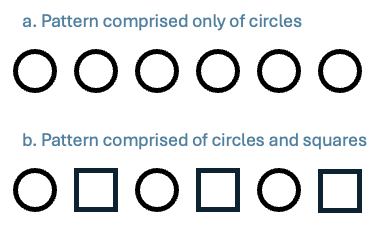IV. Diatonic Harmony, Tonicization, and Modulation
Diatonic Sequences in Middles
John Peterson
Key Takeaways
- A sequence is a pattern that has been repeated and transposed
- There are two categories of sequences: ascending and descending.
- Descending sequences include: Descending fifths (circle-of-fifths) and Descending thirds (Pachelbel).
- Ascending sequences include: ascending 5-6 (ascending step).
- When writing a sequence:
- Write the whole model
- Write the entire first chord in copy 1
- Follow the pattern of intervals to complete the remaining copies
Overview
A sequence is a pattern that has been repeated and transposed (Example 1). The term “model” refers to the initial statement of the pattern, and the term “copy” refers to subsequent repetitions of the pattern. Sequence models are typically comprised of a two-chord pattern and a melody, and both the chords and melody get transposed in subsequent copies of the pattern. It’s possible for only the melody or only the harmony to be sequential. In such cases we usually specify “melodic sequence” or “harmonic sequence.” When we just say “sequence” it usually means both melody and harmony participate.
Example 1. Two sequences in “Some People” from Gypsy (0:03–0:19)
Perhaps one of the most challenging tasks in analyzing sequences is determining where the model and its copies are. Beginning analysts often identify things that are too short to qualify as a model for a pattern. It can be helpful to remember that the model should usually contain more than one chord, very often two chords. Example 2 shows why. Example 2a shows a pattern comprised only of circles, whereas Example 2b shows a pattern that alternates circles and squares. In 2b, it’s easy to identify what the pattern is that’s being repeated (circle–square). In 2a it’s unclear: are two circles being repeated every time? Three? Both? What is the model?

Example 2.Two potential patterns.
We can divide sequences into two main categories: those that descend and those that ascend. Within each of those categories, certain sequences are so common that we have given them special names. The most common ones are covered below. It’s important to emphasize two things here, though: (1) these are not the only kinds of sequences. It’s just that these ones are quite common. Unnamed sequences can simply be labeled “ascending sequence” or “descending sequence”; (2) unfortunately, music theory has all kinds of different naming conventions for the common sequences below. We have chosen to give two common names for each one, but other naming conventions exist.
Descending sequences
Descending fifths (a.k.a. circle-of-fifths)
Descending fifths sequences involve a two-chord model being transposed down by step (Examples 3 and 6). The sequence is called “descending fifths” because each successive chord root descends by fifth (or ascends by fourth—the inversion of a fifth. Composers do this to avoid writing an unreasonably large range which would happen if they kept descending by fifth). The excerpt in Example 3 happens to use all diatonic seventh chords, but the sequence can also happen with triads alone or with every other chord having a 7th. Sometimes, instead of using all root position chords, as in Example 3, composers choose to alternate root position and first inversion chords (Example 6d).
Example 3. A descending fifths sequence in Isaac Albéniz’s Catalonia, Rehearsal 34–36.(6:56–7:00)
Descending thirds (a.k.a Pachelbel)
Descending thirds sequences involve a two-chord model being transposed down by third (hence the name “descending thirds”) (Examples 4 and 7). Some people choose instead to call this sequence “Pachelbel” after his Canon in D, which features a version of the sequence. It’s common to see the sequence involve all root position chords (as in Example 7d) or alternating root position and first inversion chords (as in Example 4).
Example 4. A descending Thirds sequence in Amanda Maier’s Six Pieces for Violin, No. 6, mm. 162–169. (2:48–3:01)
Ascending sequences
Ascending 5–6 (a.k.a ascending step)
Ascending 5–6 sequences mimic a two-chord pattern by prolonging a single chord using something called “5–6 technique” in an upper voice. The 5–6 here comes from figured bass. It simply means a voice that is a fifth above the bass moves to a sixth above the bass. Example 5 shows an ascending 5–6 sequence and Example 8c shows a harmonic reduction of the sequence that highlights the 5-6 motion in the soprano voice. Notice in Example 5 that when the 5th moves to the 6th, we could decide to label a new chord. Although we prefer to use fewer Roman numerals, we’ve also shown an alternative analysis that labels every possible verticality.
Example 5. An ascending 5-6 sequence in Antonio Vivaldi’s Violin Concerto Op. 8, No. 4, II, mm. 11–13.(1:15–1:36)
Writing sequences
Writing sequences is easiest if you establish the model first and then “copy-and-paste” the voice leading for each subsequent copy. Note that your copy should exhibit the same voice leading as your model, but transposed to a different pitch level, otherwise it’s not a sequence. For that reason, it’s important that you double check the writing in the model. Any error that you make in the model will get repeated to all subsequent copies. The steps are:
- Write the model
- Follow the typical writing procedure here, and prefer a soprano that is smoother rather than leapy.
- Write the entire first chord of your first copy.
- Copy the exact same spacing from the first chord of your model. For instance, if the third of the chord is in the soprano in the model’s chord 1, then the third of the chord must also be in the soprano for every copy’s chord 1.
- Determine the pattern of intervals you’ve written for each voice (soprano, also, tenor, bass) and copy that pattern to the end of the sequence.
- You can check if you’ve done it right quickly by seeing if the spacing of the final chord matches its analogous partner in the model.
- If you’re in minor, remember to raise the leading tone only if a dominant-function chord is resolving to tonic.
Examples 6–8 walk through these steps for each of the sequences we’ve covered in this chapter.
Example 6. Writing descending fifths sequences.
Example 7. Writing descending thirds sequences.
Example 8. Writing ascending 5-6 sequences.
A pattern that is repeated and transposed by some consistent interval. A sequence may occur in the melody, the harmony, or both.
The segment of music that establishes the pattern for a sequence; in other words, the segment that gets copied in a sequence.
The segment of a sequence that repeats and transposes the material from the model.

